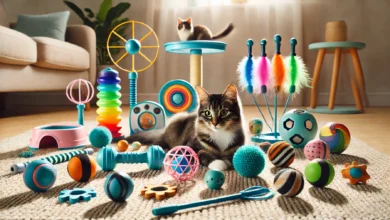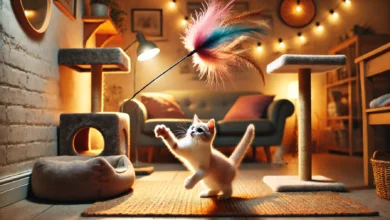Exploring Eco-Friendly Toys for Sustainable Cat Play
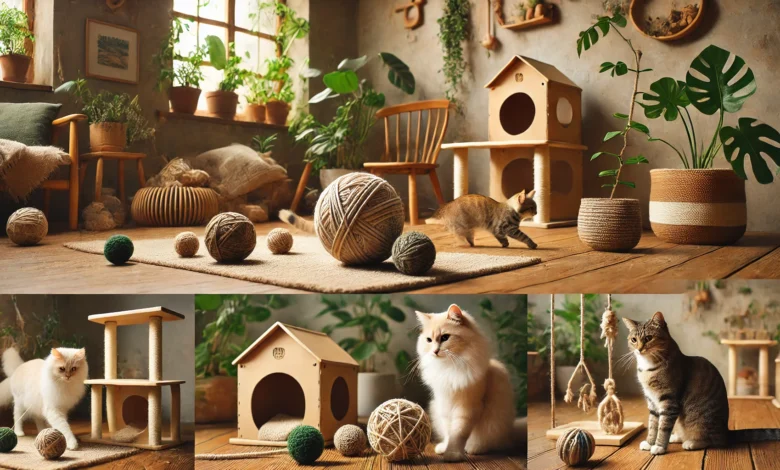
As cat owners, we always try to seek ways to keep our little feline friends happy and healthy.
One area where we can make a positive difference is in the choice of toys for our cats.
With increasing awareness of the need for sustainability and how consumer goods are affecting the environment, it is similarly important that we consider eco-friendly toys for our cats.
Eco-friendly toys not only bring fun and stimulation but also contribute to a healthy environment due to the reduction of waste and use of only natural, safe materials.
Here, we look at the benefits that eco-friendly cat toys can bring, the best types available, and how to choose the right ones for your cat while keeping in mind how sustainable they are.
Table of Contents
Why Choose Eco-Friendly Toys for Your Cat?
The trends seem to be that pet owners who care about both their pets and the environment have started to choose eco-friendly toys for them.
But why should you consider eco-friendly toys for your cat, particularly?
Well, there are a number of good, compelling reasons why this switch is not only good for them but for the planet, too.
First, all eco-friendly cat toys are prepared with materials that are naturally occurring and fully sustainable, hence causing minimal damage to the environment compared to conventional plastic toys.
Most conventional pet toys are made using synthetically manufactured materials, part of the building blocks of pollution and environmental degradation.
In choosing alternatives, you will be able to reduce your carbon footprint while still allowing your cat to have fun playing with interesting toys.
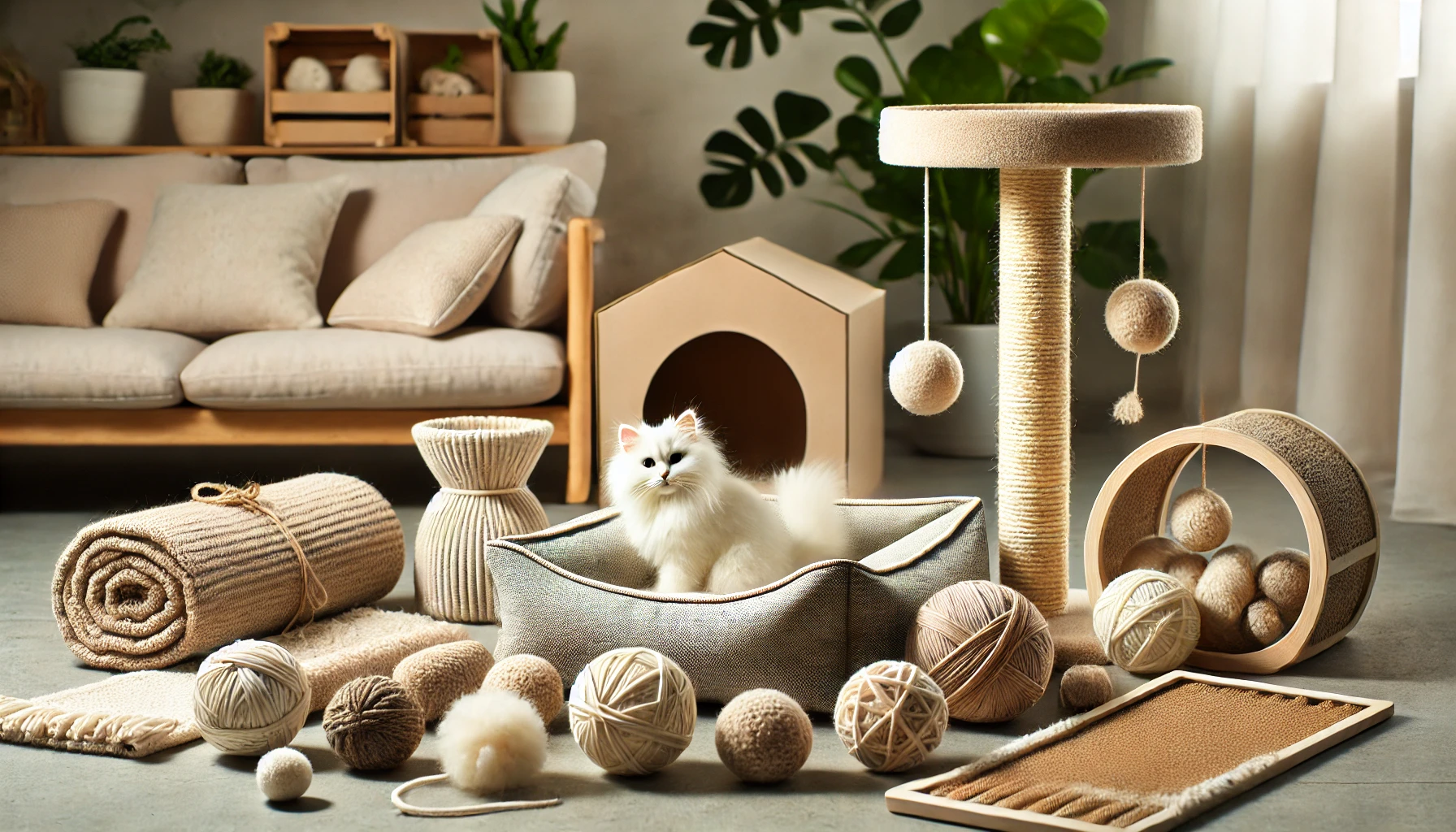
The Importance of Sustainability in Pet Products
When one thinks about sustainability, it is mostly related to household goods and packaging from food.
However, in this regard, pet products also include toys, which are a great factor for waste minimization and keeping the environment healthy.
Normally, sustainable cat toys are made of materials such as organic cotton, hemp, wool, or recycled fabrics that can decompose naturally after some time, unlike plastic toys that take decades to decompose.
With eco-friendly cat toys, on the other hand, you’re supporting companies that initiate ethical production methods.
These could be small businesses or even artisans who carefully craft each toy by hand to ensure that toxic chemicals and substances do not make it into the manufacturing process.
This can be especially important for your cat, who will be playing with safe, nontoxic toys that pose no threat to their health or the health of the environment.

Benefits of Eco-Friendly Cat Toys to the Environment
Yet, eco-friendly toys are good not only for your cat but also for the environment.
Traditional plastic-based toys only add to the problem of plastic pollution that keeps growing and growing.
A few million tons of plastic origin waste end up in landfills or the ocean every year, thereby posing threats to wildlife and ecosystems.
Eco-friendly cat toys made from natural materials or recyclates fight against this by reducing waste and further developing renewable resources.
Besides this, most eco-friendly toys have a minimal impact on the manufacturing process.
Many of the eco-friendly brands run on renewable energy, conserve water, and limit packaging waste.
This is a holistic approach to sustainability, ensuring your purchase makes a difference in the world.
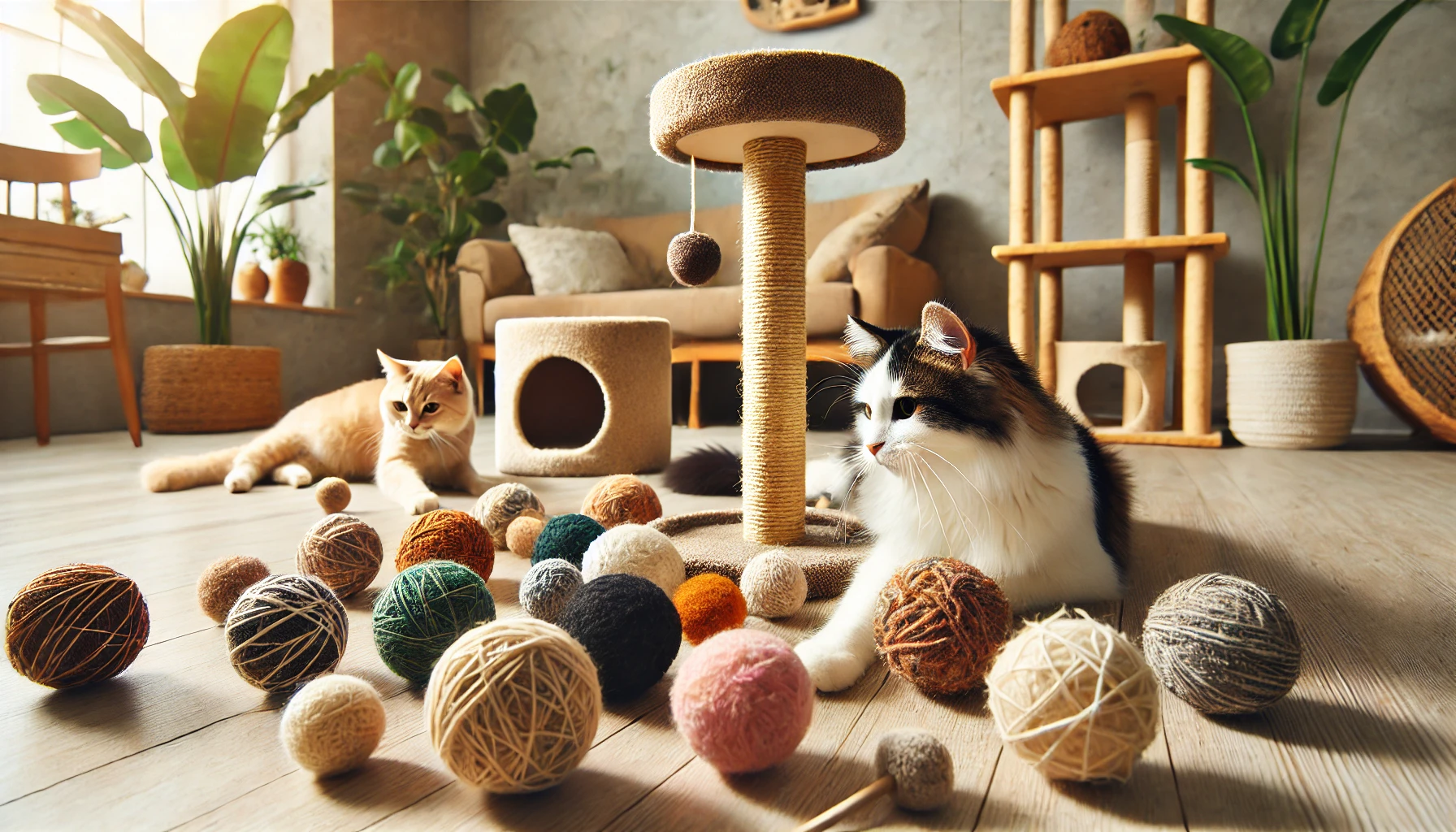
How Eco-Friendly Toys Promote Healthier Play for Cats
Of course, the health and safety of your cat are the first consideration, taken into great account with eco-friendly toys.
While many plastic toys in mass production can pose chemical hazards, eco-friendly options are made from safe, nontoxic materials.
This is very important because cats often chew or lick their toys when playing with them.
You will be sure that your cat plays with something that doesn’t hurt him/her.
Eco-friendly toys also afford more natural play behaviors.
For example, those toys made from hemp or wool have textures that your cat would find in nature, which can be extremely stimulating and pleasurable for your cat.
They tend to be tougher, too, and can bear some rough play while lasting longer, reducing the need to replace them frequently.
Choosing eco-friendly toys for your cat reduces environmental impact by using natural, safe materials and helps promote sustainability for a healthier planet.

Materials Used in Eco-Friendly Cat Toys
When it comes to choosing the best toys for your cat, the materials used in eco-friendly toys play a very important role.
These materials not only determine whether the toy will be safe and durable but also contribute significantly to the environment.
Here we review some of the most common materials one may find in eco-friendly cat toys and why they are beneficial to both your furry friend and the environment.

Natural and Biodegradable Materials
Eco-friendly cat toys are made wholly from natural materials.
These are biodegradable and able to degrade with time.
The most common examples are:
- Organic Cotton: Grown without toxic pesticides or chemicals, organic cotton is soft for your cat to play with and fully biodegradable.
- Hemp: Hemp is a super sustainable plant known for its strength and durability. Toys made from hemp are non-toxic to chew and even resistant to mold and bacteria.
- Wool: Soft, resilient, and renewable, wool is great for making toys. Felted wool toys are quite popular as the different textures will truly intrigue your feline friend.
- Recycled Fabrics: Some toys are made from recycled materials, like rags, pieces of cloth, or old clothes, that help reduce waste and further support recycling.
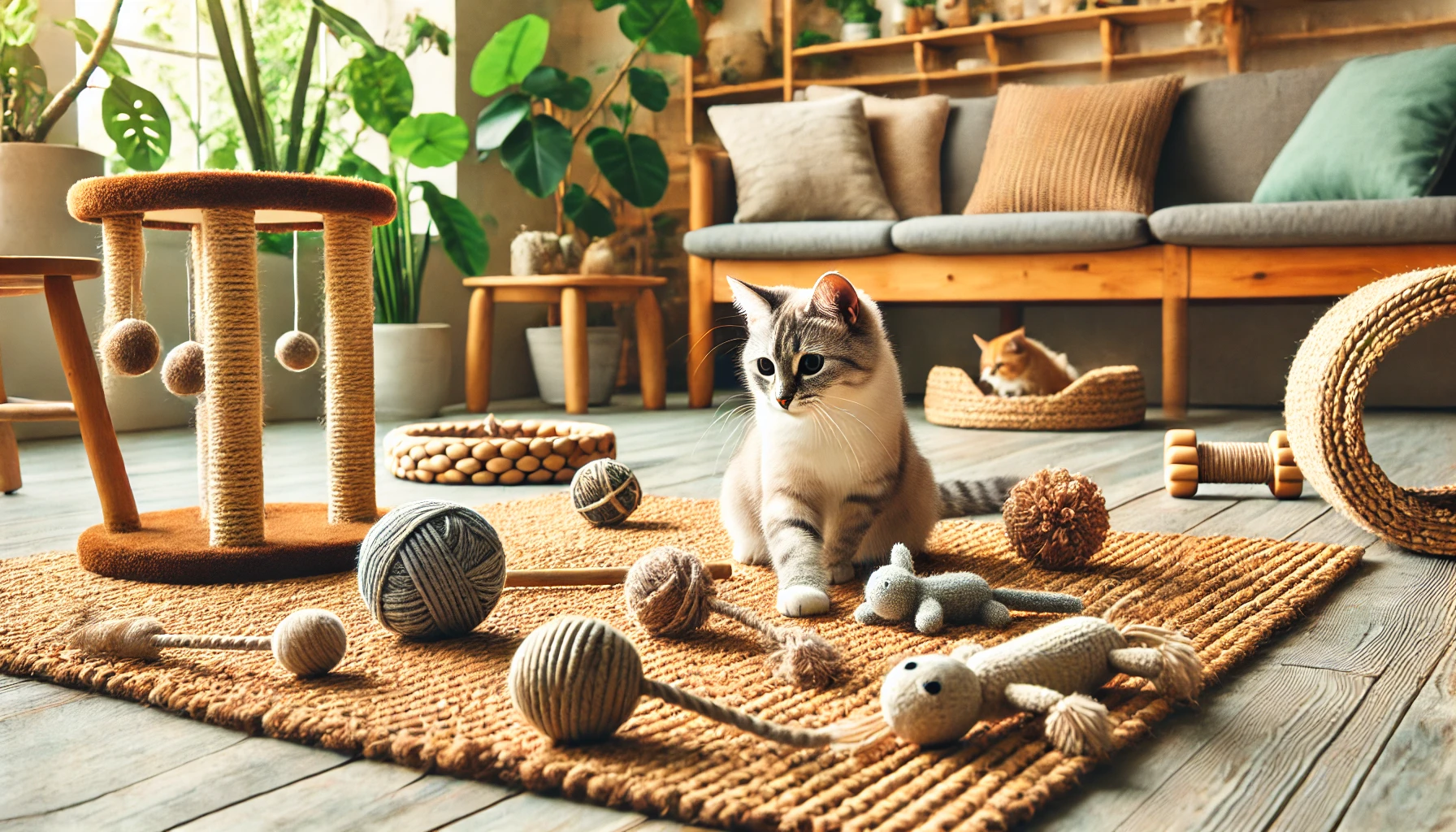
Non-Toxic and Safe for Cats
Among the top concerns regarding traditional pet toys are possible toxic chemicals.
Eco-friendly toys prioritize the safety of your cat by using non-toxic materials.
They are free from:
- Phthalates: These chemicals, which are frequently found in plastic toys, are toxic to your cat.
- Lead and Heavy Metals: Most traditional toys are made with lead and other harmful metals; these can be ingested and may result in critical health complications.
- Artificial Dyes: Instead, natural dyes, which are prepared from plants or minerals, are used to color the eco-friendly toys so that your feline does not have any dangerous chemicals in its toys.

Recycled and Upcycled Components in Toys
Apart from natural materials, most eco-friendly cat toys incorporate recycled and upcycled parts in them.
This innovative approach, apart from reducing waste, gives new life to old material.
For example:
- Recycled Plastic: Some eco-friendly toys are made with a composition of recycled plastic bottles, hence helping to divert waste from landfills.
- Upcycled Fabrics: These can be used to create soft toys from post-consumer fabrics, hence being both eco-friendly and one-of-a-kind.
All in all, when you opt for these as a means of eco-friendly cat toys, you ensure a safer playing time with your feline friend while at the same time going easy on Mother Nature.
It’s a real win-win!
The materials used in eco-friendly cat toys, such as organic cotton, hemp, and recycled fabrics, offer durability and are safe for both your cat and the environment.
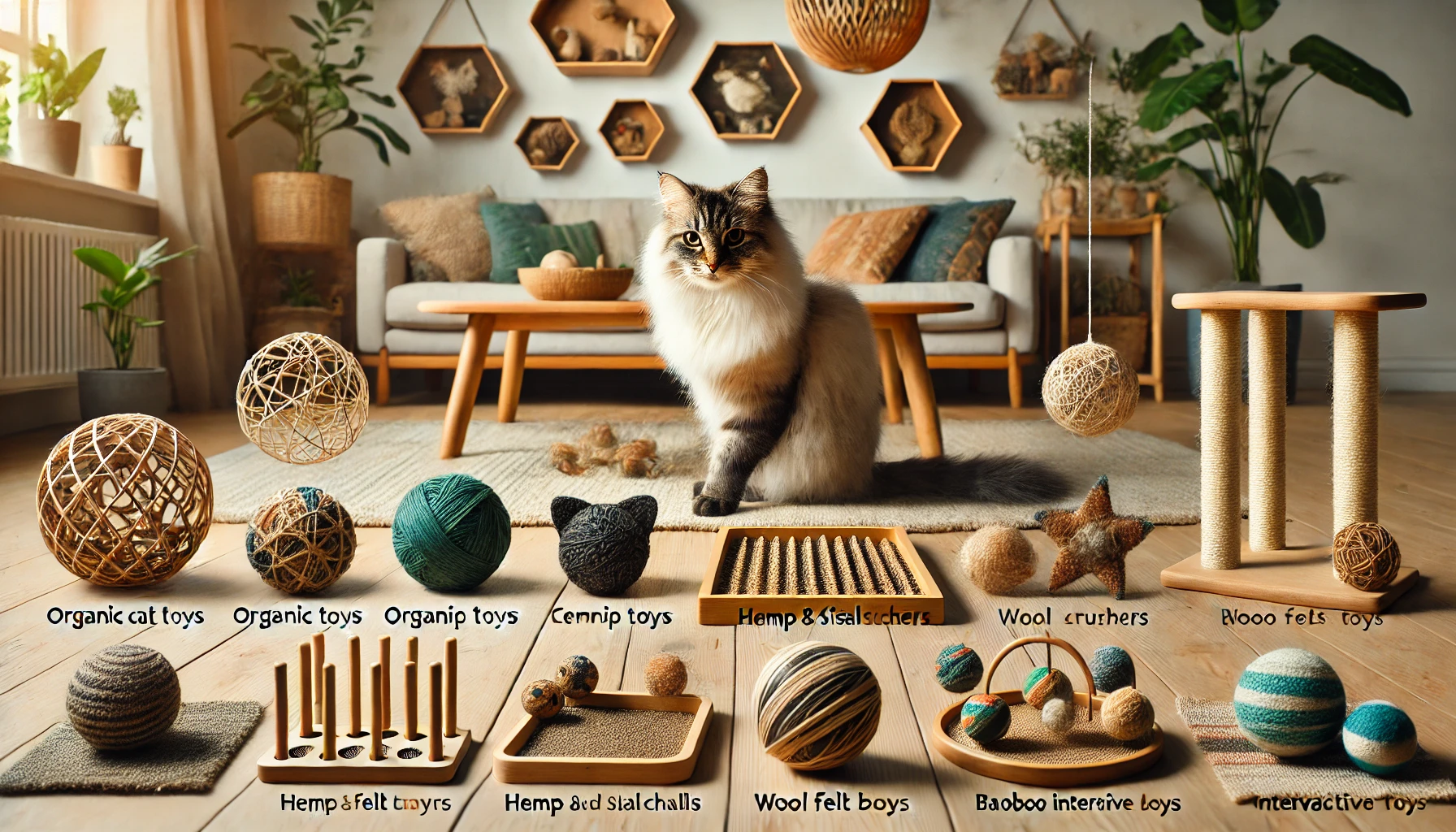
Top Eco-Friendly Toy Types for Cats
Picking the right toys for your cat will adequately challenge both their mind and body.
Such is the case when considering eco-friendly toys, with a wide variety to keep your cat amused while at the same time appealing to greener dimensions.
In this section, we look at some of the best types of eco-friendly cat toys one can present to a feline friend.
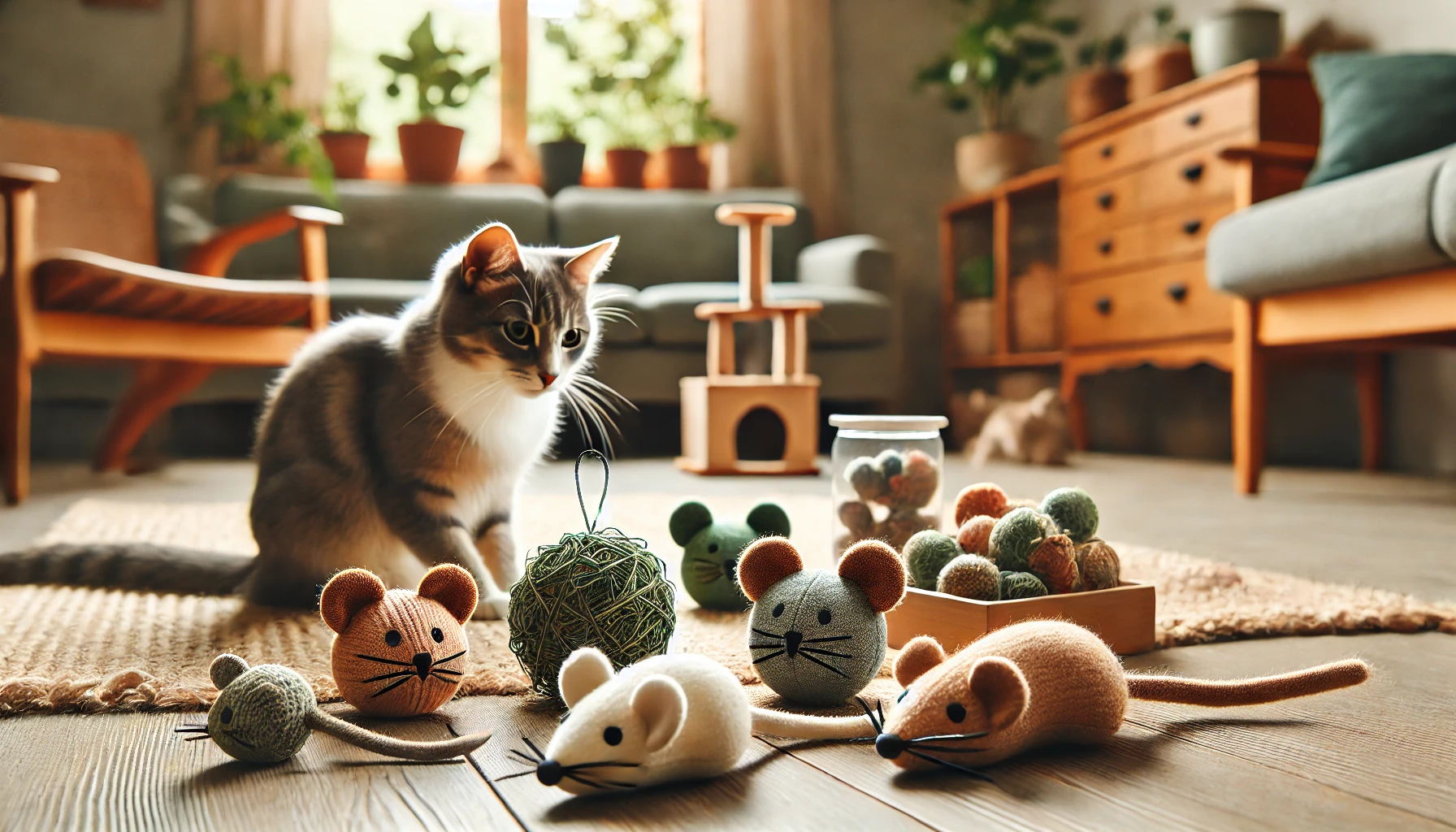
Organic Catnip Toys
Many cats enjoy playing with their catnip toys, and organic catnip toys come with the assurance that your feline friend will enjoy his playtime naturally.
High-quality, organically grown catnip fills these toys to tempt your cat to display playful antics, stimulating them mentally and exercising them.
They could also be made from biodegradable materials, which makes them much more coveted by responsible pet owners.
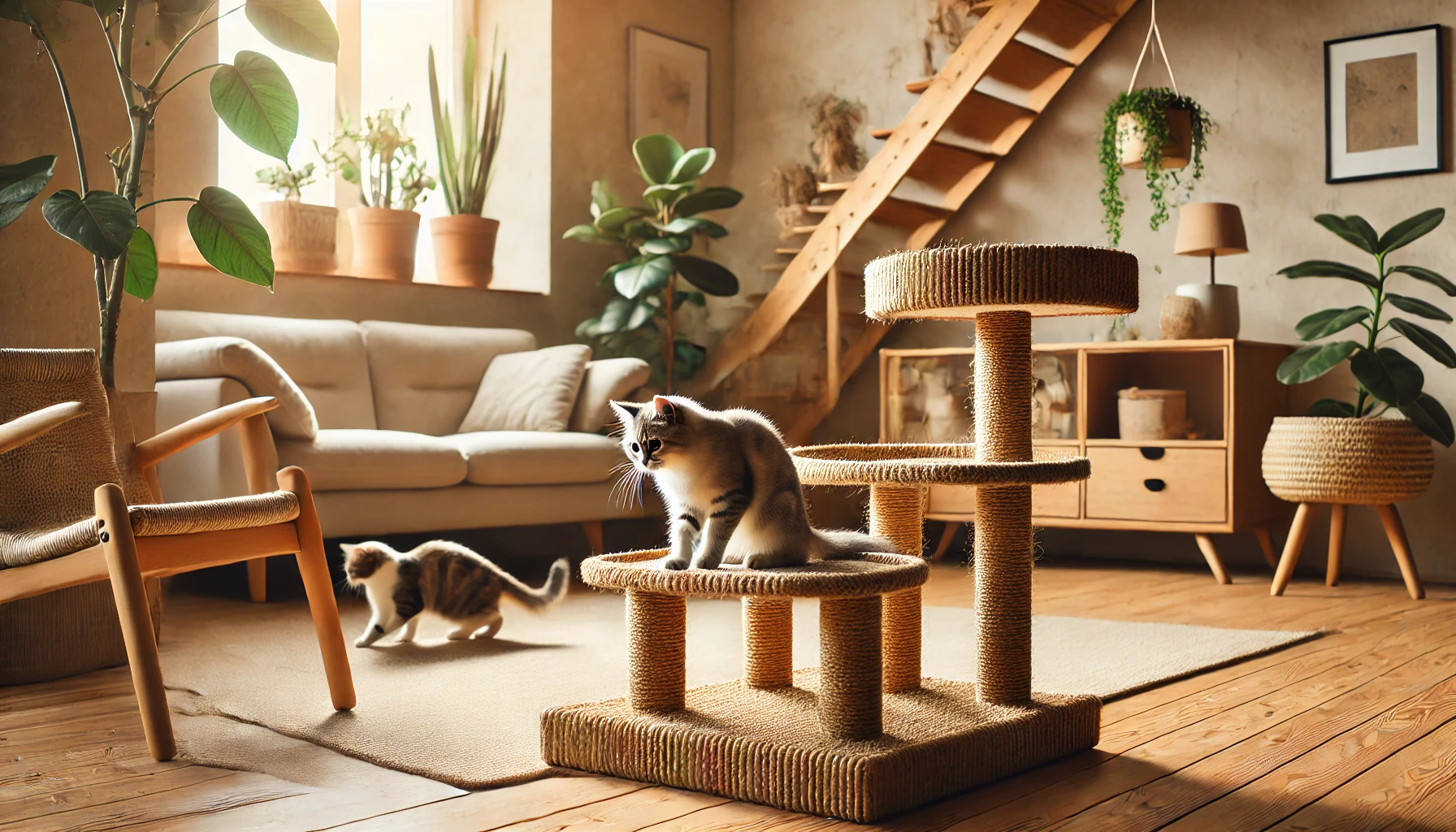
Sisal and Hemp Scratchers
Cats scratch naturally.
Satisfy that behavior with eco-friendly scratchers made of sisal and hemp.
Sisal is a really resistant natural fiber that will withstand scratching sessions.
Hemp is also a very good material since it is strong and sustainable for production.
These scratchers will maintain your cat’s healthy claws and can prevent them from scratching your furniture.
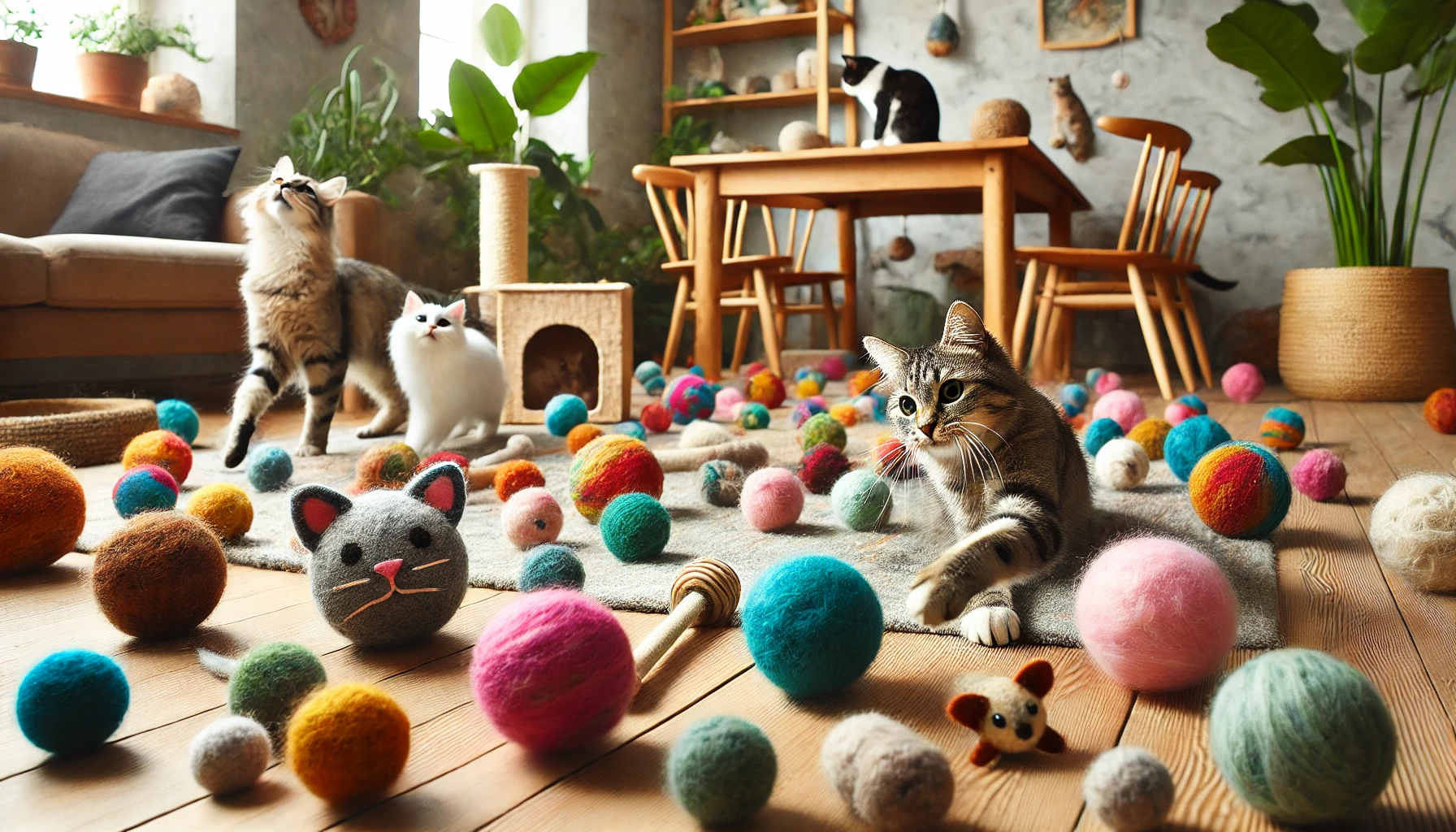
Wool Balls and Felted Toys
Wool balls and felted toys are very cute but provide your cat with a safe and pleasurable playing experience.
Because they are made from natural wool, these toys are soft and very durable, many of them having natural dyes, making them non-toxic.
Cats enjoy batting these kinds of toys around, and the different textures might fascinate them enough to truly enjoy playtime.
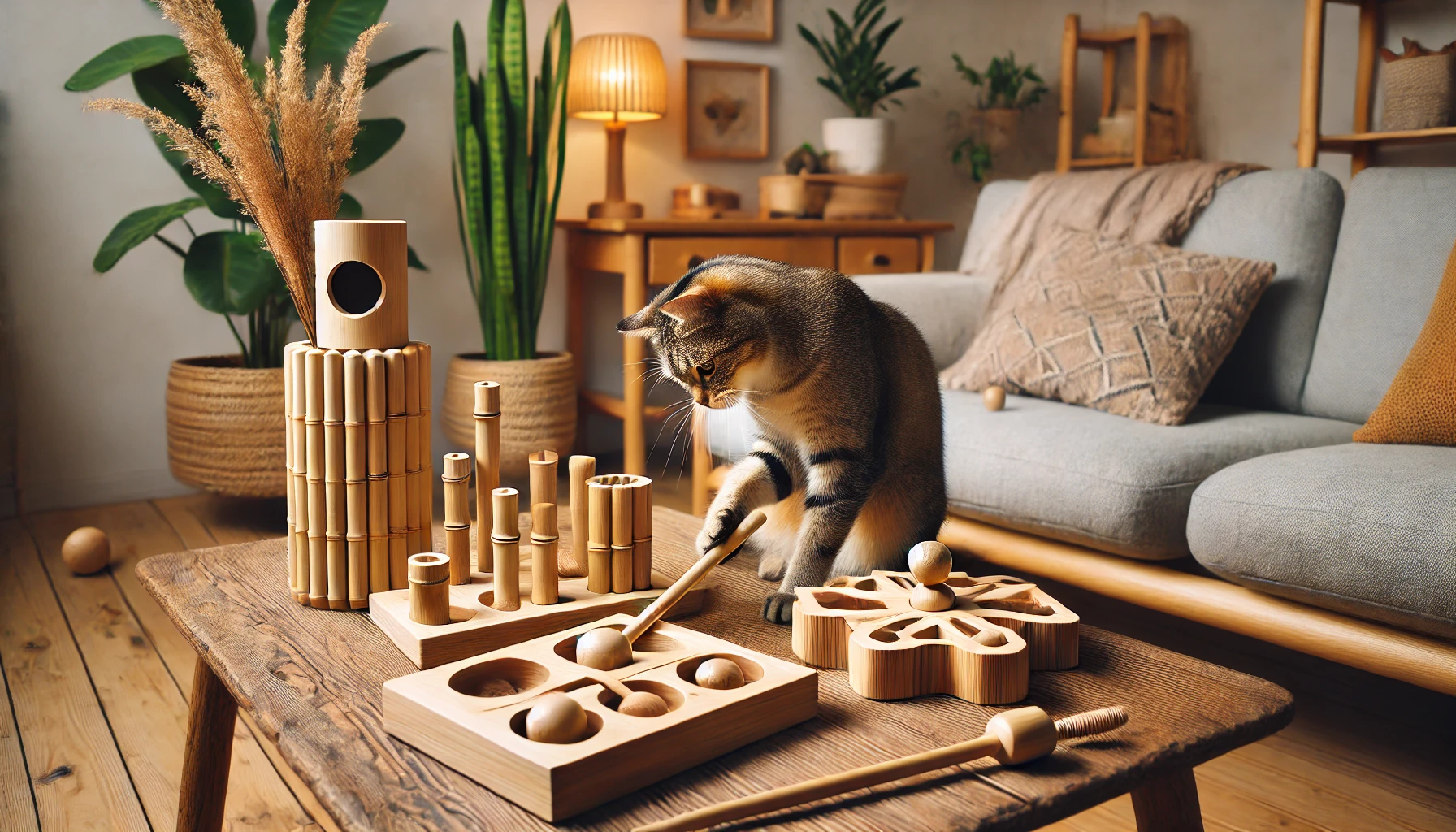
Interactive Bamboo or Wooden Toys
Interactive toys are perfect for exercising your cat’s mind.
They come in durable, eco-friendly options made from bamboo or reclaimed wood.
These toys can also be made into various forms—for instance, into puzzle feeders or even cat wands.
This allows your feline friend to have some challenging time using their brains and engaging in active play.
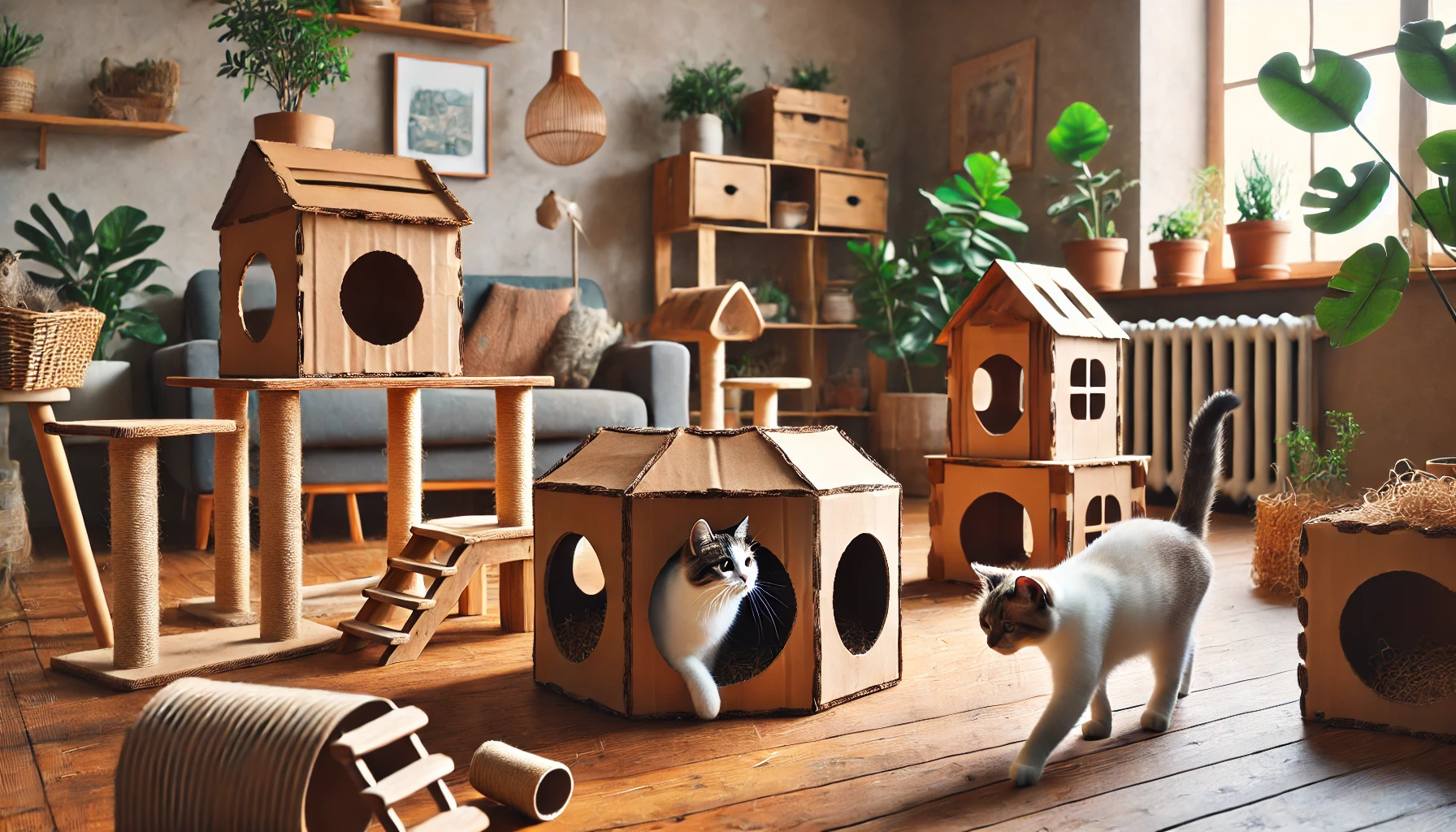
Recycled Paper and Cardboard Playhouses
Another easy eco-friendly toy option includes playhouses constructed out of recycled paper or cardboard.
Cats are known to show a great deal of affection for investigating and concealing themselves in boxes.
The cardboard playhouses provide them with an adventurous, secure place to play.
They are also fully recyclable, making their environmental impact as small as possible.
Even better, you can easily make DIY cardboard toys at home using materials that otherwise would have been discarded.
By adding these types of eco-friendly cat toys to your cat’s playtime, you can ensure they have a fun and enriching experience while you support sustainable practices.
These toys don’t just satisfy the instinctive needs of your cat but also contribute toward less waste in the environment.
Eco-friendly cat toys come in a variety of types including organic catnip toys, hemp scratchers, and wool balls, providing natural, safe, and sustainable options for play.
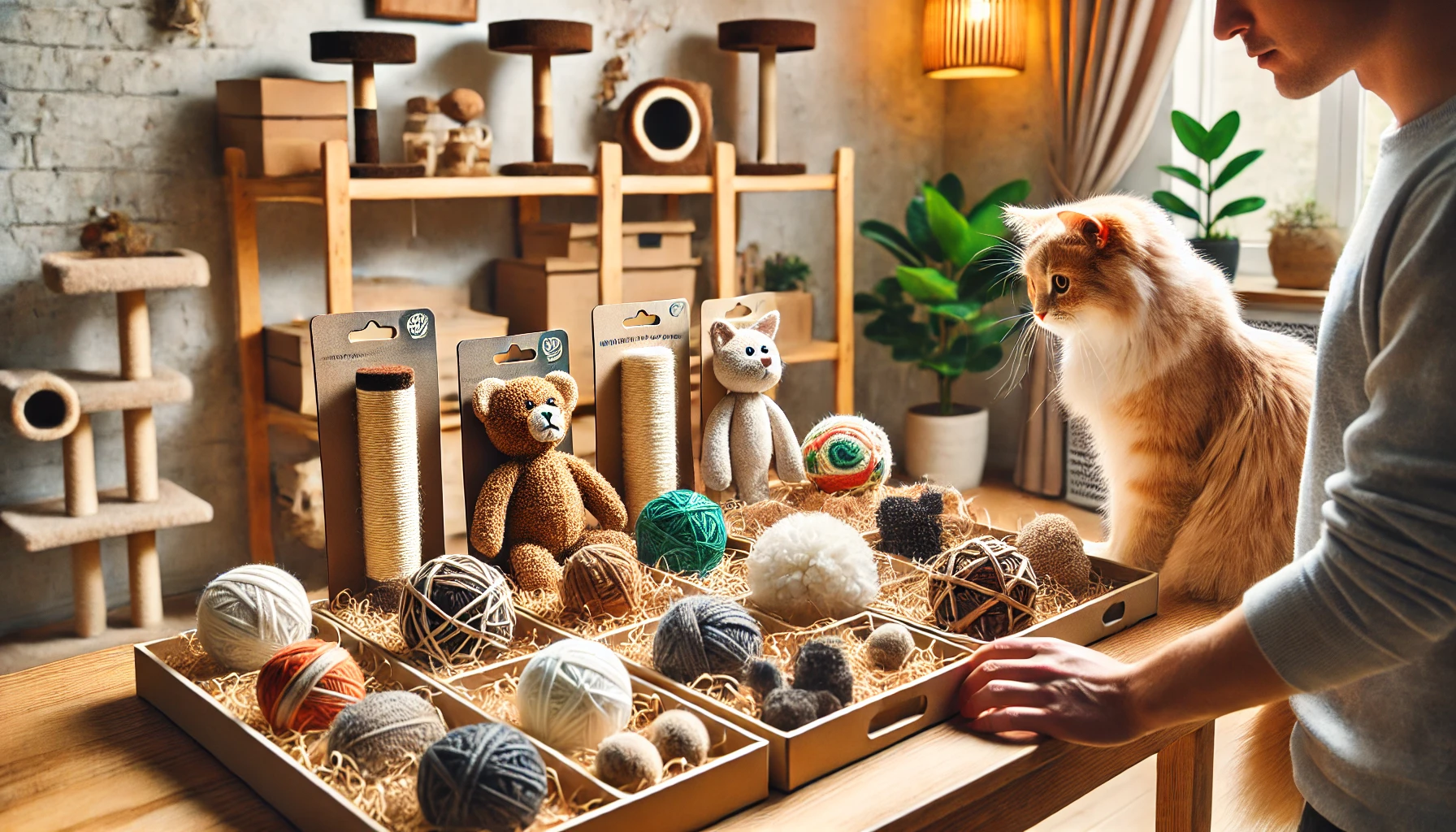
How to Choose the Best Eco-Friendly Toy for Your Cat
Seeking the ultimate eco-friendly toy for your feline companion?
Here’s a list of what you should consider to ensure that they will be enjoyable, safe, and non-harming to the environment.
The options are numerous, making it not an easy task.
Here are some basic guidelines you may lean on to choose the best for your cat.
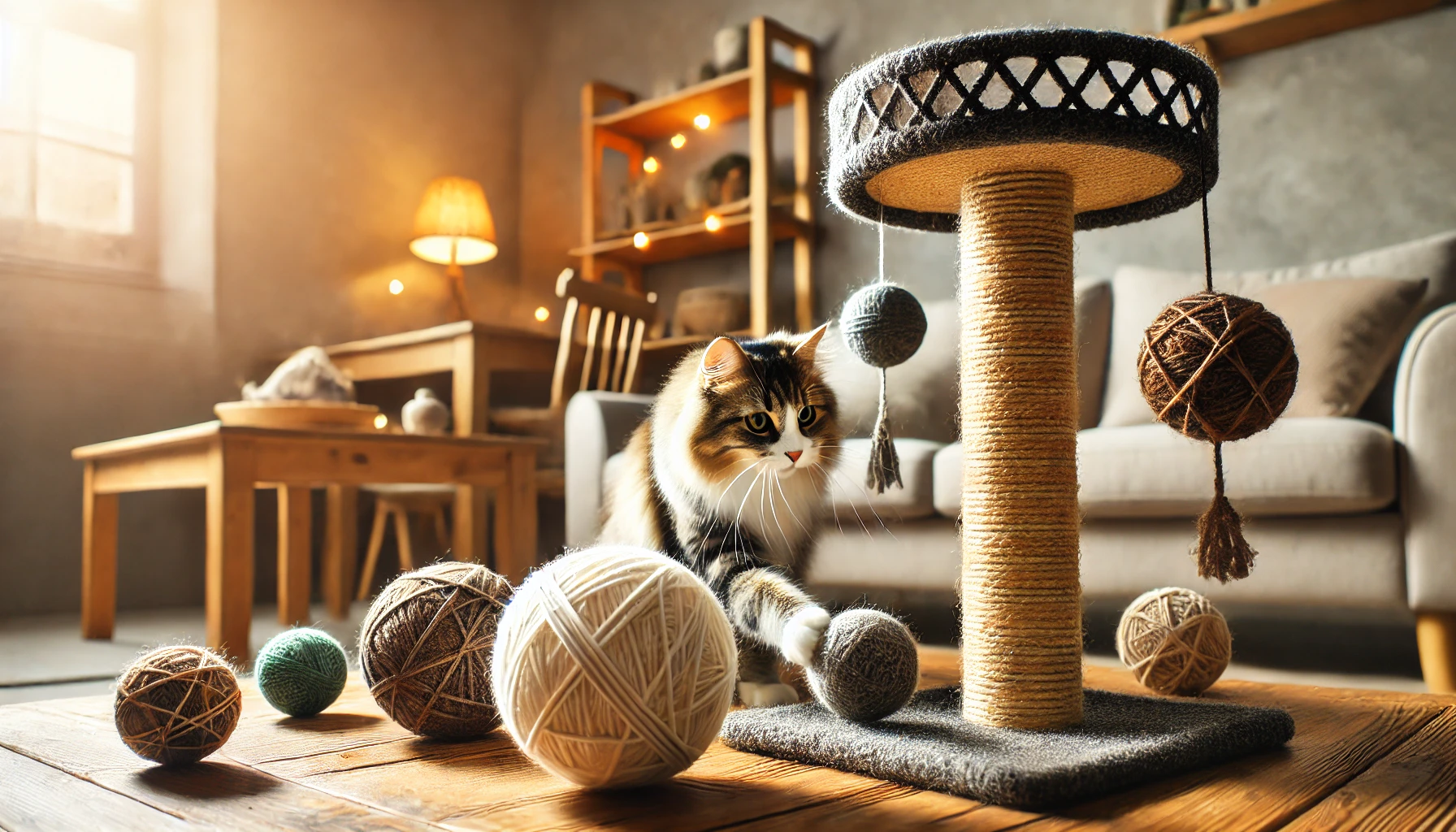
Evaluating Durability and Longevity
Probably the most important thing to remember about choosing your eco-friendly cat toys is that they should be very well made.
Cats can indeed be rough with their toys, so you want to select items made from sturdy, high-quality materials.
Consider the following:
- Quality of Material: Make sure the products are made of strong materials, like sisal, organic cotton, and hemp, which allow for scratching and chewing.
- Construction: A well-constructed toy is less likely to fall apart and will generally last longer.
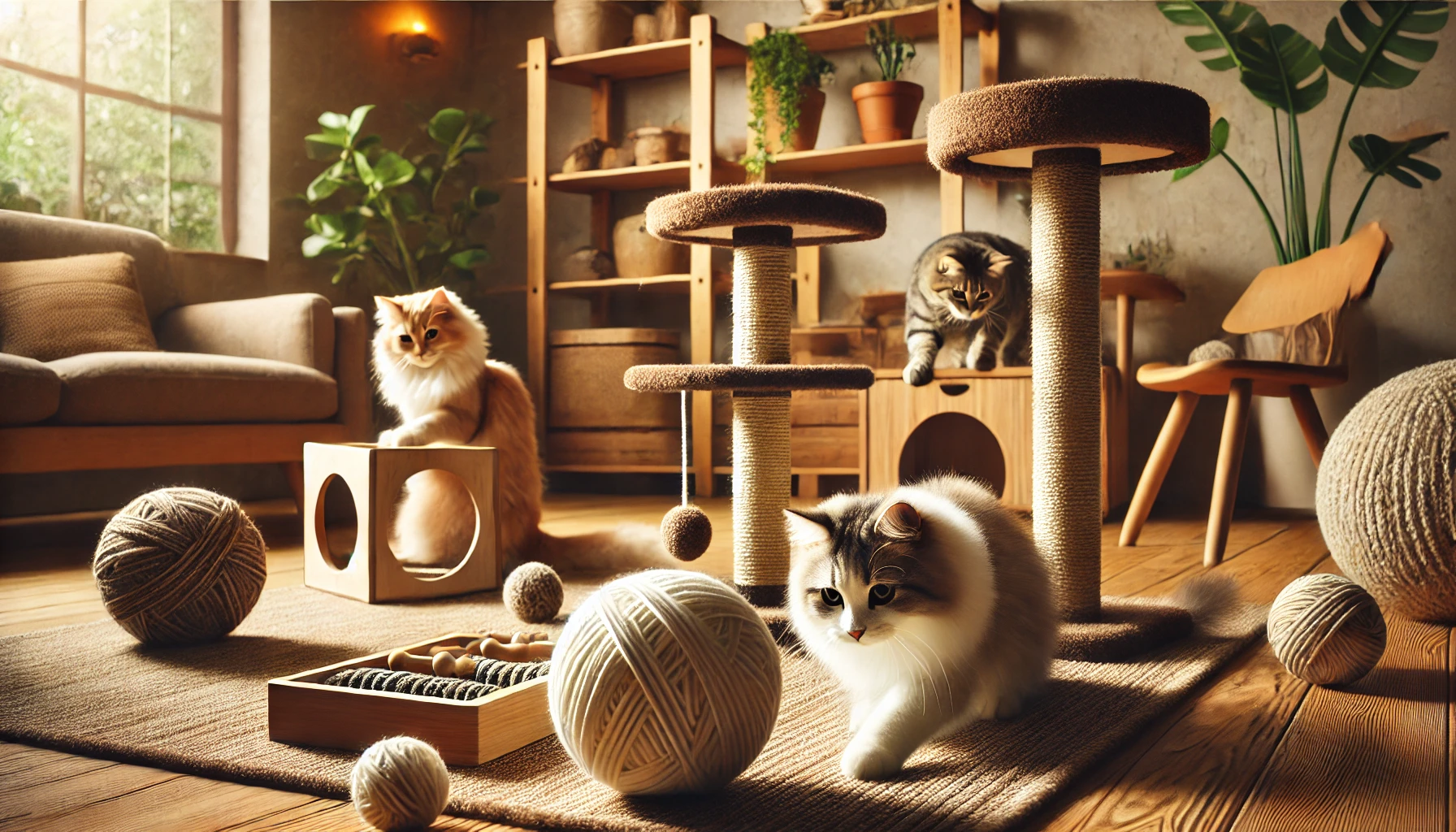
Considering Your Cat’s Play Style and Preferences
Each cat is different, and they all tend to have a specific way of playing.
Some may enjoy chasing and batting, while others like chewing or scratching.
You can work out the best eco-friendly option for your cat by observing their behavior:
- Active Play: If your kitty is very playful and likes to run around and jump, then interactive toys or balls will be their best fit.
- Relaxed Play: Cats that indulge in passive play will find soft toys or those filled with catnip very appealing.
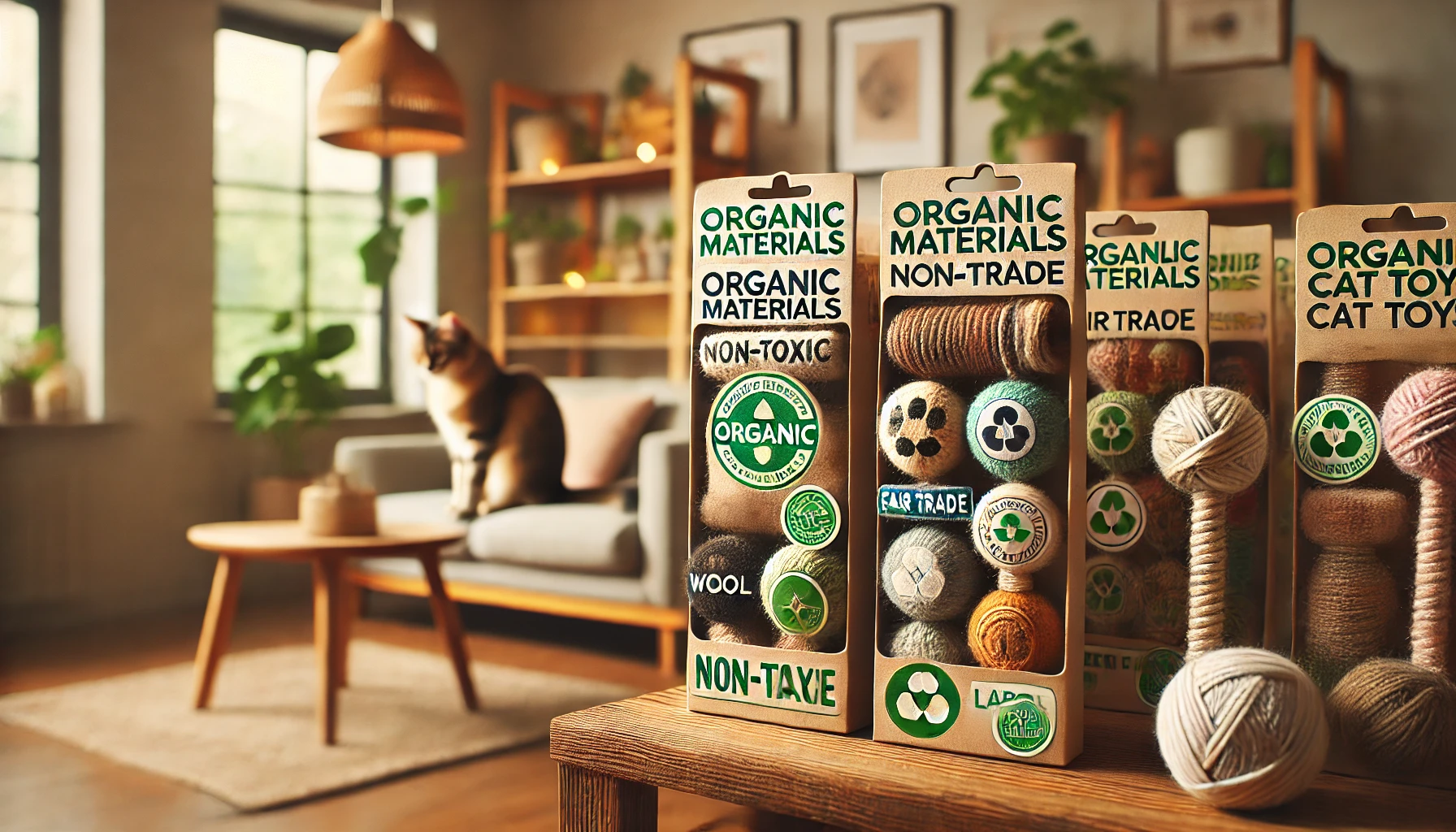
Checking for Certifications and Eco-Labels
When purchasing eco-friendly toys, make sure to check for certifications or eco-labels, which prove that the toy has passed the test of certain safety and sustainability standards.
Important certifications to look for include:
- Global Organic Textile Standard (GOTS): This certification assures that only organic materials are used during production.
- OEKO-TEX Certification: Assures that textiles are free from harmful substances.
- USDA Organic: Demonstrates that products are made from organic materials with no synthetic additives.

Thinking of the Environment
While being safe for your cat, it is equally important to ensure that the toy will not harm the environment.
Opt for toys that are:
- Biodegradable: Made from materials that can easily decompose.
- Recycled: Toys made from recycled materials contribute less to waste.
- Locally Made: This often means fewer carbon emissions from transportation.
Follow these guidelines in selecting the best eco-friendly toys for your kitty companion.
The best way to ensure that they will enjoy safe, fun, and sustainable playtime is to continue reducing your carbon footprint.
Your decisions not only make your feline friend happy but also help keep the planet healthy.
When choosing an eco-friendly toy, consider durability, your cat’s play style, and certifications for sustainability to ensure both your pet and the environment benefit.
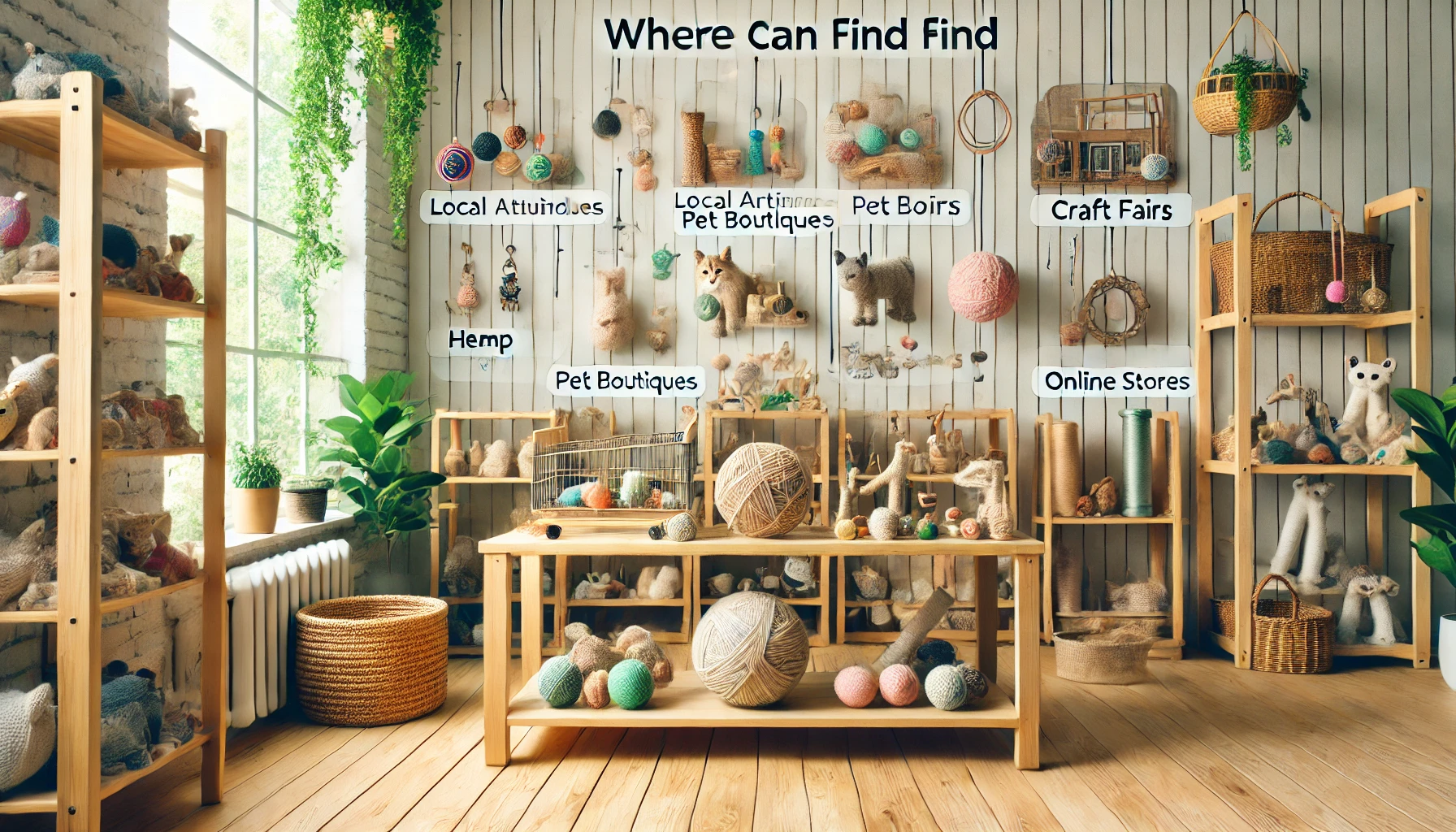
Where to Find Eco-Friendly Cat Toys
Finding the right eco-friendly toys for your cat has never been easier, thanks to the increasingly high demand for sustainable pet products.
Places to get good eco-friendly cat toys range from online to local.
Here are some great options:
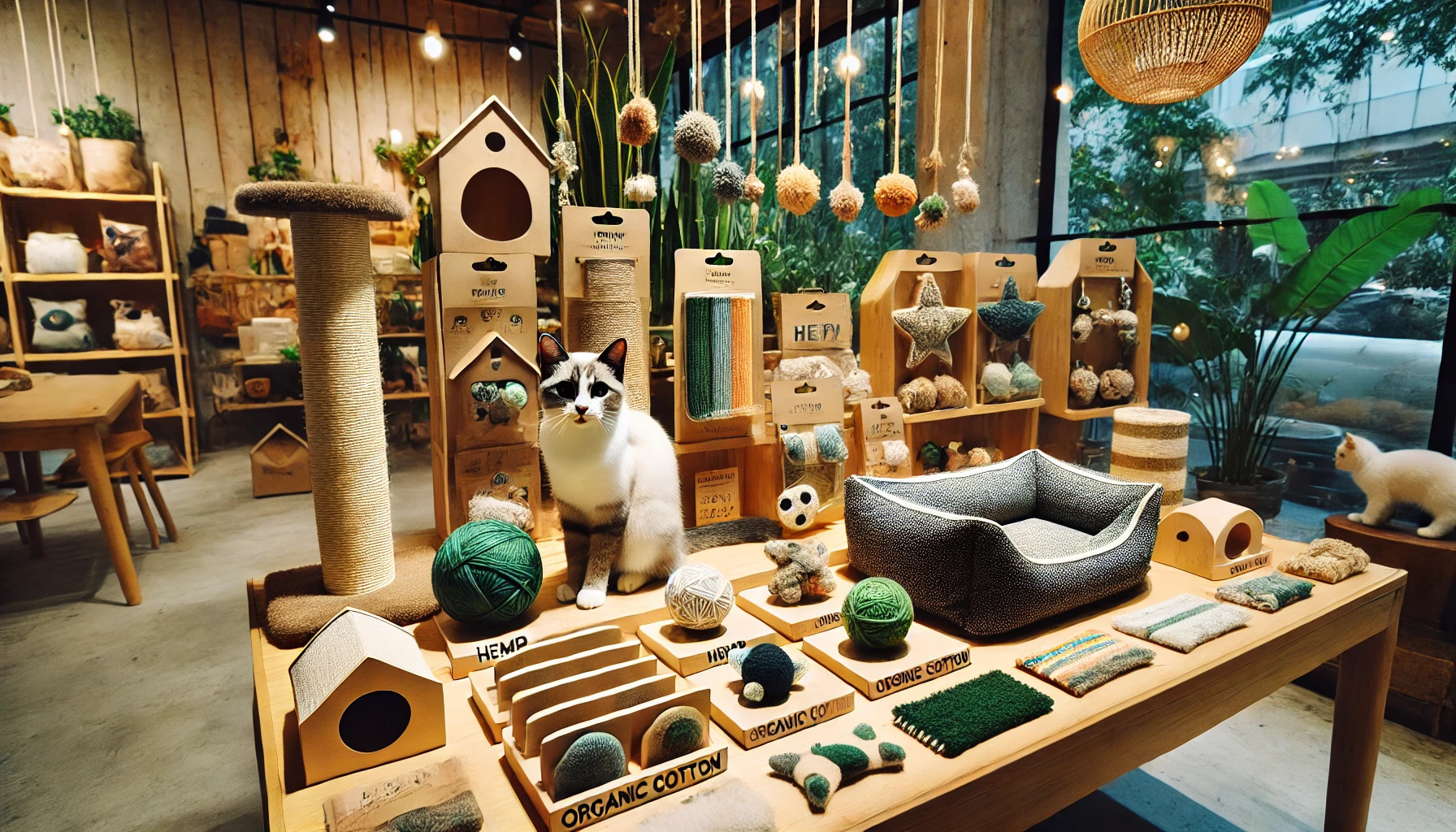
Brands Specializing in Sustainable Pet Products
Many brands focus on creating eco-friendly pet products.
A few popular ones to consider include:
- West Paw: Offers a variety of toys made from recycled materials and is committed to sustainability in their manufacturing process.
- PetFusion: Known for their eco-friendly cat scratchers and toys, the materials used in PetFusion products are sustainable, non-toxic, and safe for pets and the environment.
- Wooly Pet: This brand specializes in wool toys and presents excellent, durable, biodegradable alternatives for your cat.

Local and Artisan Makers of Eco-Friendly Toys
Another great way to find unique, handmade eco-friendly cat toys is by supporting local artisans.
Some ideas include:
- Craft Fairs and Farmers’ Markets: Many local artists showcase their handcrafted pet accessories. More often than not, you’ll find sustainable toys not available in stores.
- Local Boutiques for Pets: Look for small pet shops in your town. Many boutique stores will carry only eco-friendly and sustainable products.
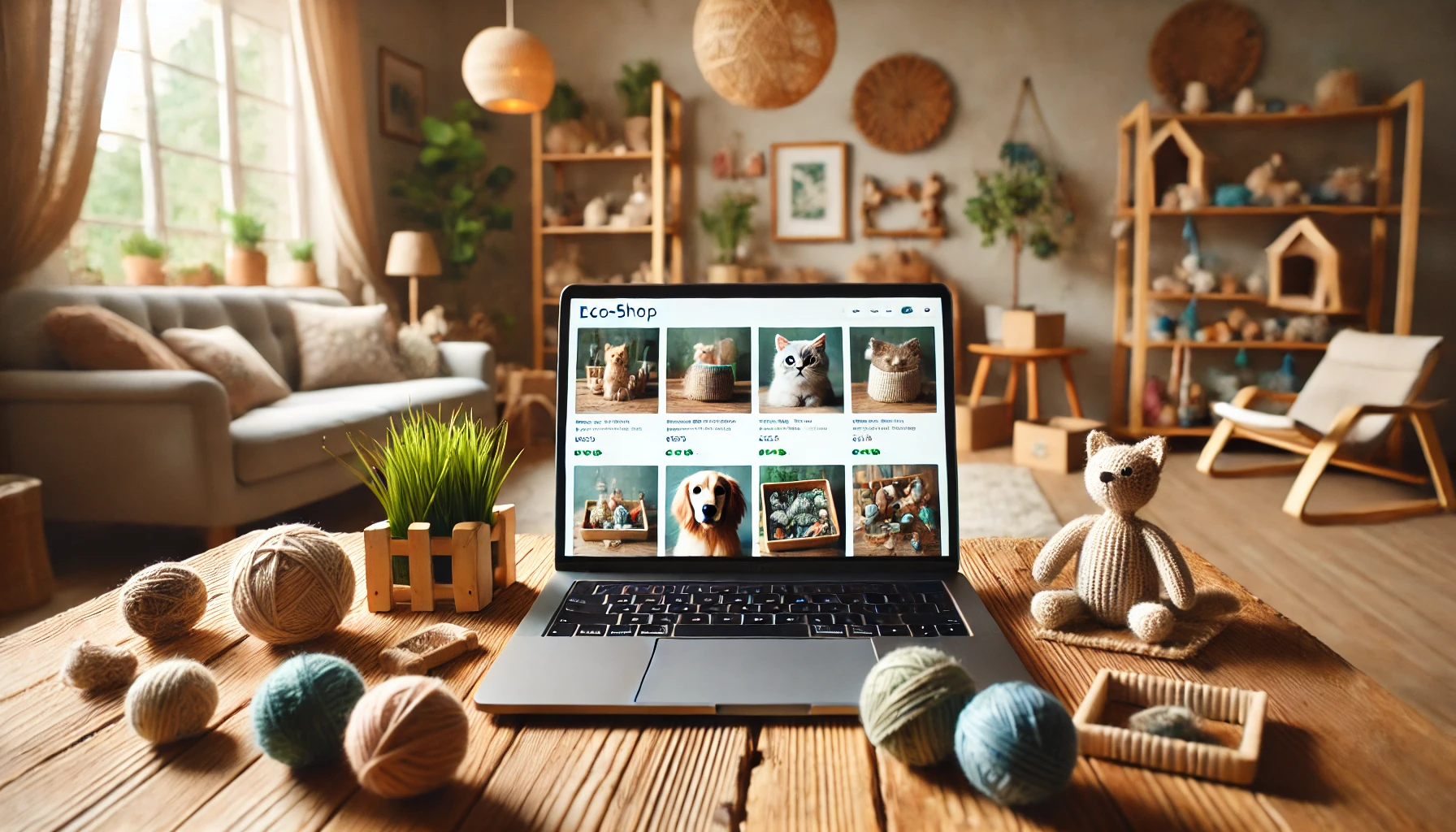
Online Eco-Shops for Pets
If you prefer online shopping, there are several places specializing in eco-friendly products:
- Amazon: You can sift through eco-friendly options by filtering specifically for sustainable pet products or certifications.
- Etsy: This website features a number of one-of-a-kind, handmade items; many artisans create eco-friendly toys for pets.
- Chewy: This well-liked online pet supply website has made finding eco-friendly cat toys a breeze with an entire section dedicated to them.
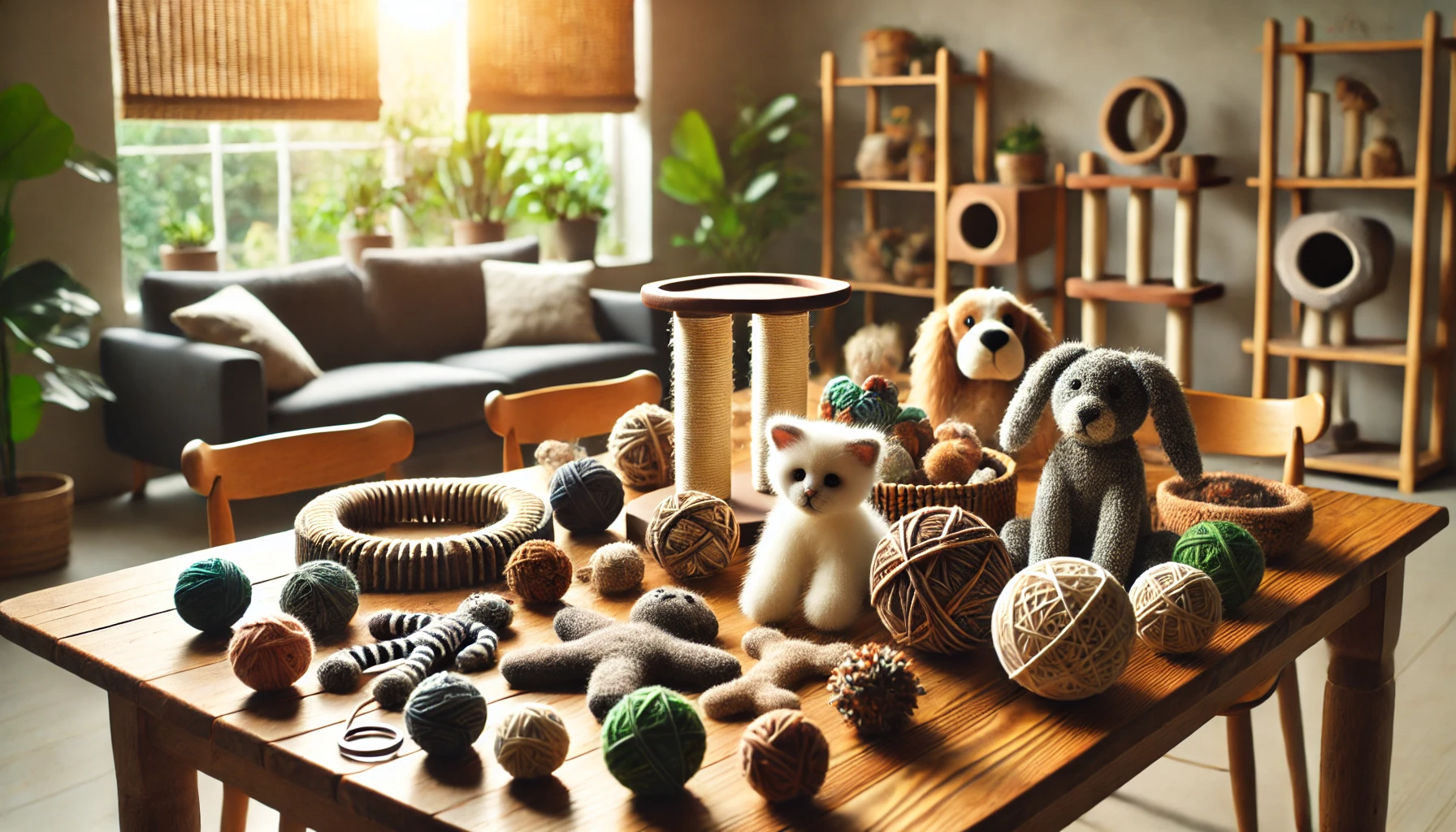
Second-Hand Options
Buying second-hand toys can also be considered a form of eco-friendliness.
Here’s how to do it:
- Thrift Stores: Many thrift stores carry pet toys that are still in very good condition.
- Online Resale Platforms: Websites like Poshmark or Facebook Marketplace have sections for pets where secondhand toys can be found.
By considering these options, you can discover various kinds of eco-friendly cat toys that cater to your cat’s needs while promoting sustainability.
Remember, choosing an eco-friendly toy will not just help your feline friend but also benefit the environment!
Eco-friendly cat toys can be found at local boutiques, online eco-shops like Etsy, and even through brands that specialize in sustainable pet products.
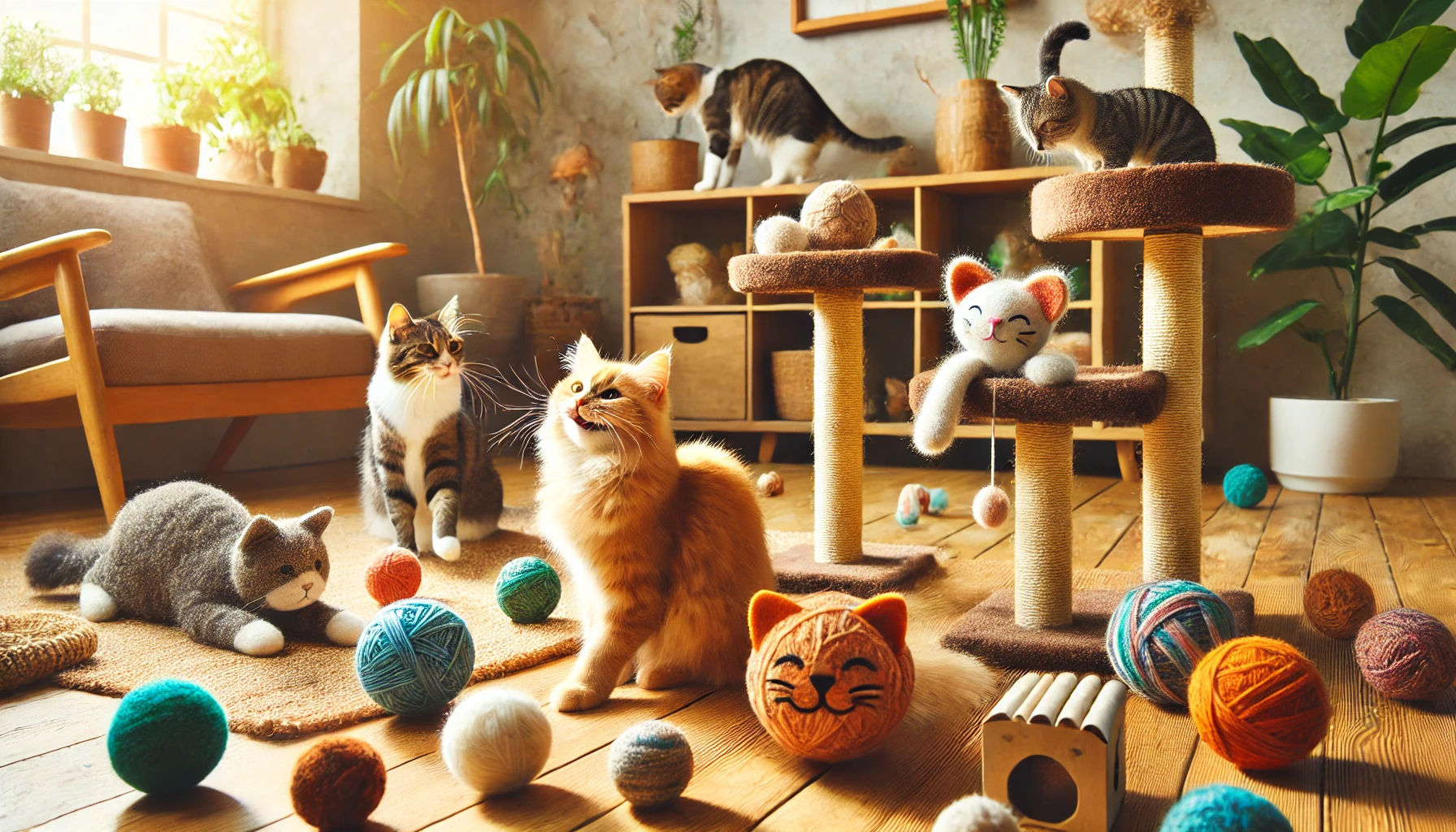
Embracing Eco-Friendly Toys for a Happier Cat
A decision to switch to eco-friendly toys for cats will not only be great for your feline friend but also for the environment.
You can let your cat have safe, fun playtime while going greener by opting for sustainable, nontoxic alternatives.
We have discussed different aspects of eco-friendly cat toys in this article, starting with the materials that can be used and where to find them.
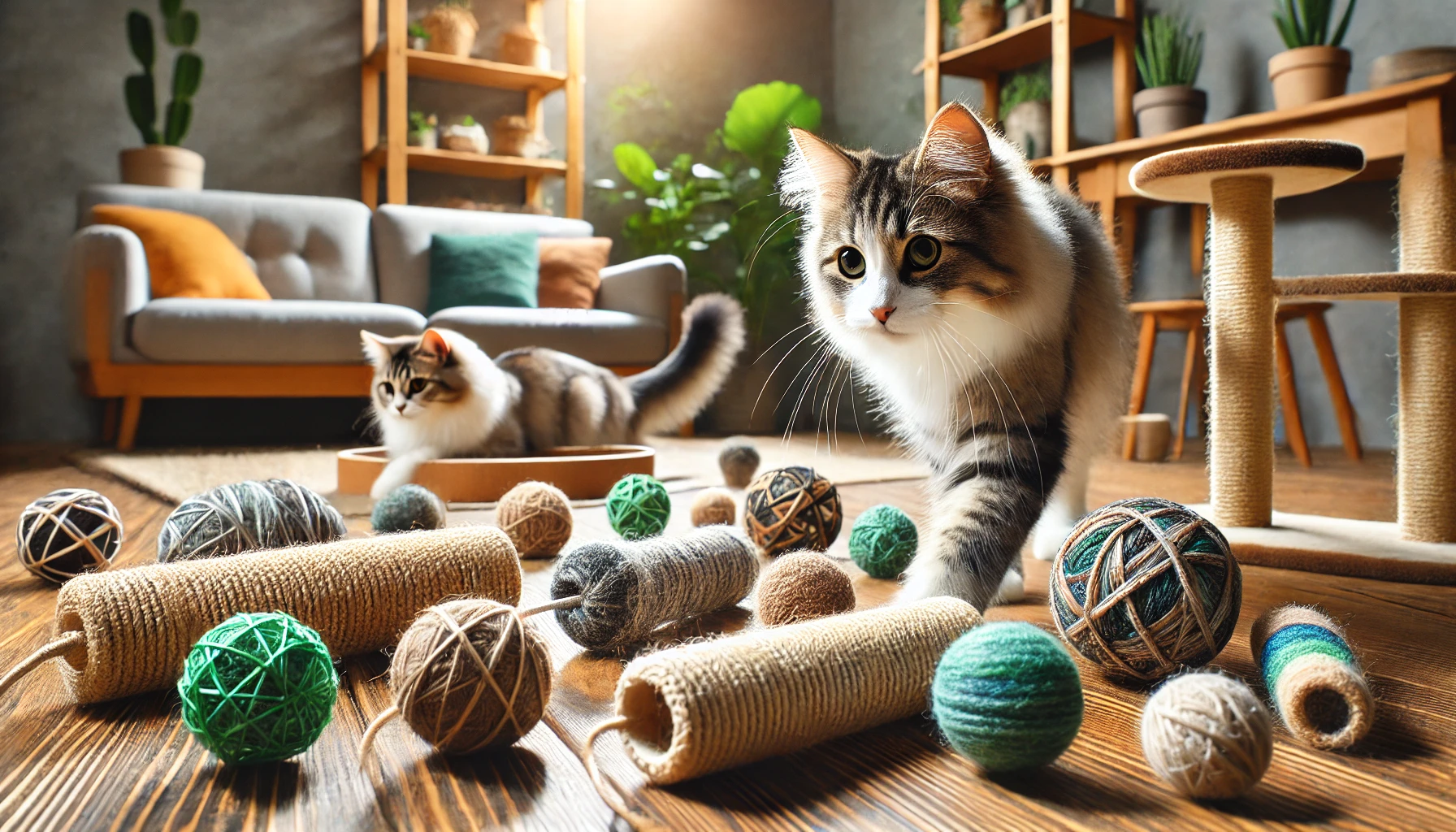
The Advantages of Eco-Friendly Cat Toys
Investing in eco-friendly cat toys has several advantages, such as:
- Sustainability: Purchasing products or investing in brands that prioritize eco-friendly practices contributes to environmental health.
- Safety: Because natural materials are used, you can be assured that your cat will play with toys free from harmful chemicals.
- Durability: Many eco-friendly toys are made from robust materials, ensuring that they last longer.
- Unique Options: Handmade toys provide special choices that can enhance your cat’s playtime.

Important Things to Consider in Choosing Eco-Friendly Toys
As you set out to get the ideal eco-friendly toy for your cat, consider the following factors:
- Consider Durability: The toys should be well-made from durable materials.
- Know Your Cat’s Preferences: Observe your cat to understand how they like to play, helping you choose the best toy for them.
- Look for Certifications: Ensure sustainability and safety through eco-labels.
- Consider Environmental Impact: Make purchases that are biodegradable and made from recycled materials whenever possible.
By being informed and following this guide, along with embracing the use of environmentally friendly cat toys, you’ll contribute to a healthier Earth.
Your feline friend is sure to experience delightful playtime.
Let this choice not only enrich your cat’s experience but also reflect the values you stand for in harmony with nature.
Switching to eco-friendly toys benefits your cat by providing safe, sustainable play options while supporting efforts to protect the planet.

Frequently Asked Questions about Eco-Friendly Cat Toys
Below are some of the most common questions regarding eco-friendly toys for cats, along with their answers to help you make informed decisions.
What are eco-friendly cat toys made from?
Eco-friendly cat toys are normally made from natural, renewable materials such as organic cotton, hemp, wool, and recycled fabrics, ensuring the toy is safe for your cat while causing minimal harm to the environment.
Are eco-friendly toys safe for my cat?
Yes, eco-friendly toys can be safe for cats, as they are made from non-toxic, natural materials free of hazardous chemicals commonly found in conventional plastic toys.
Where can I buy eco-friendly cat toys?
You can find eco-friendly cat toys online through Amazon and Etsy, at local pet boutiques, craft fairs, or from companies that specialize in sustainable pet products.
Do eco-friendly toys last as long as traditional ones?
Many eco-friendly cat toys are made from tough materials like sisal or hemp, allowing them to withstand rough play and last just as long as traditional toys, if not longer.
Are there any specific certifications for eco-friendly toys?
Yes, there are specific certifications for eco-friendly toys.
Common ones include GOTS (Global Organic Textile Standard), OEKO-TEX, and USDA Organic, which guarantee that the toy meets safety and sustainability standards.
Can I make my own DIY eco-friendly toys for my cat?
Absolutely!
You can create eco-friendly toys from old clothes, cardboard, or any other recyclable materials, allowing for creative and environmentally friendly options for your cat’s playtime.
What are the advantages of using eco-friendly toys?
Eco-friendly cat toys provide safe playtime, minimize environmental harm, promote sustainable practices, and often feature unique designs that stimulate your cat’s natural instincts and curiosity.
Are all eco-friendly toys biodegradable?
Most eco-friendly toys are biodegradable, but some are not.
Always check the materials used to ensure they can naturally decompose and won’t contribute to landfill waste.
How will I know if a toy is really eco-friendly?
Check for labels, certifications, and the materials used.
Research the brand’s commitment to sustainability in their manufacturing practices to confirm the toy is truly eco-friendly.

